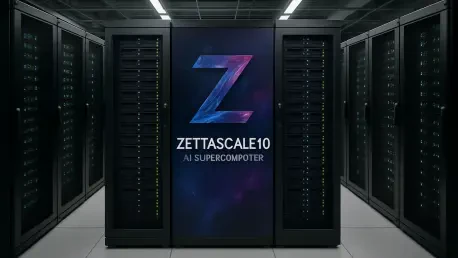Today, we’re thrilled to sit down with Chloe Maraina, a Business Intelligence expert with a deep passion for crafting compelling visual stories through big data analysis. With her sharp insights into data science and a forward-thinking vision for data management and integration, Chloe is the perfect person to help us unpack Oracle’s groundbreaking Zettascale10 supercomputer. In this conversation, we dive into the immense scale and power of this AI-driven system, explore its innovative architecture, and discuss how it’s poised to transform industries through cutting-edge generative AI applications.
Can you give us an overview of what the OCI Zettascale10 supercomputer is and why Oracle decided to push the boundaries with this project?
Absolutely. The OCI Zettascale10 is Oracle’s latest leap into AI infrastructure, designed as the largest AI supercomputer in the cloud. It’s a multi-gigawatt system that connects an astonishing 800,000 Nvidia GPUs to deliver unparalleled performance for training and running complex AI models. Oracle’s motivation behind this is to meet the growing demand for massive computational power in generative AI, especially for applications like large language models. They’re positioning themselves at the forefront of AI innovation, ensuring enterprises and research labs have the tools to tackle next-generation challenges.
What does the scale of connecting 800,000 Nvidia GPUs mean for the performance capabilities of Zettascale10?
The scale here is staggering. By linking 800,000 Nvidia GPUs, Zettascale10 achieves a peak performance of 16 zettaFLOPS—that’s a level of computational power that can handle sextillions of operations per second. This means it can process incredibly complex tasks, like training AI models on vast datasets including text, images, and video, at speeds previously unimaginable. It’s a game-changer for workloads that require massive context and inference, pushing the boundaries of what AI can achieve in real-time applications.
Can you explain the concept of a multi-gigawatt architecture in simple terms for those unfamiliar with supercomputing?
Sure, think of a multi-gigawatt architecture as the energy backbone of Zettascale10. It refers to the enormous amount of power—billions of watts—needed to run and connect hundreds of thousands of GPUs across multiple data centers. For the average person, this translates to a system that can handle an unprecedented volume of calculations simultaneously. It’s like having millions of high-powered computers working in perfect sync, but it also comes with challenges like ensuring energy efficiency and managing heat dissipation to keep the system sustainable.
Oracle introduced updates to its Acceleron networking stack with this system. Can you walk us through how these enhancements improve performance?
The updates to Oracle’s Acceleron networking stack are all about speed and cost-efficiency. Features like dedicated network fabrics and zero-trust packet routing essentially create secure, high-speed pathways for data to travel between GPUs. This can double network and storage throughput while slashing latency, meaning data moves faster with less delay. For customers, this translates to quicker workload processing and lower operational costs, as the system maximizes efficiency without compromising security or reliability.
The Zettascale10 uses what Oracle calls a ‘wide, shallow, resilient’ fabric. Can you break down what that means and why it matters?
This design is fascinating. A ‘wide, shallow, resilient’ fabric means the network architecture is spread out broadly with minimal layers, allowing for direct, fast connections between components. It’s resilient because it can adapt to issues like unstable network paths by rerouting traffic to alternative planes. This matters because it enables faster deployment of massive clusters and reduces stalls or restarts during heavy workloads. Essentially, it keeps the system running smoothly even under intense demand, which is critical for AI training at this scale.
How did Oracle achieve power efficiency and high density in the design of Zettascale10, and why is that significant?
Oracle focused on power-efficient optics and a hyper-optimized layout, keeping clusters within a tight two-kilometer radius on large data center campuses. This minimizes energy loss over long distances and maximizes compute power by concentrating resources. It’s significant because it reduces operational costs and environmental impact while ensuring high performance. The density also improves reliability—shorter distances mean lower latency and fewer chances for signal degradation, which is crucial for maintaining the system’s effectiveness.
With Zettascale10 set to be available in 2026 and orders already being taken, what can potential customers expect from this rollout?
Customers signing up for Zettascale10 can expect access to a truly cutting-edge platform starting in the second half of 2026. Oracle is targeting industries and organizations with heavy AI needs—think research labs, tech giants, and enterprises working on generative AI applications. They’re planning multi-gigawatt deployments, starting with clusters of up to 800,000 GPUs. Customers will benefit from accelerated performance and scalability tailored to specific industry use cases, though they’ll need to plan for integration given the sheer power and complexity of the system.
What is your forecast for the future of supercomputing and AI infrastructure as systems like Zettascale10 become more prevalent?
I believe we’re on the cusp of a transformative era in supercomputing and AI infrastructure. As systems like Zettascale10 become more common, we’ll see a democratization of high-powered AI tools, even if indirectly through partnerships and cloud services. The focus will shift toward energy efficiency and accessibility, ensuring smaller enterprises can tap into this power without building their own mega-factories. I also expect rapid advancements in AI applications—think real-time processing of multimodal data at scale—reshaping industries from healthcare to entertainment. The challenge will be balancing this growth with sustainability and equitable access, but the potential for innovation is limitless.









